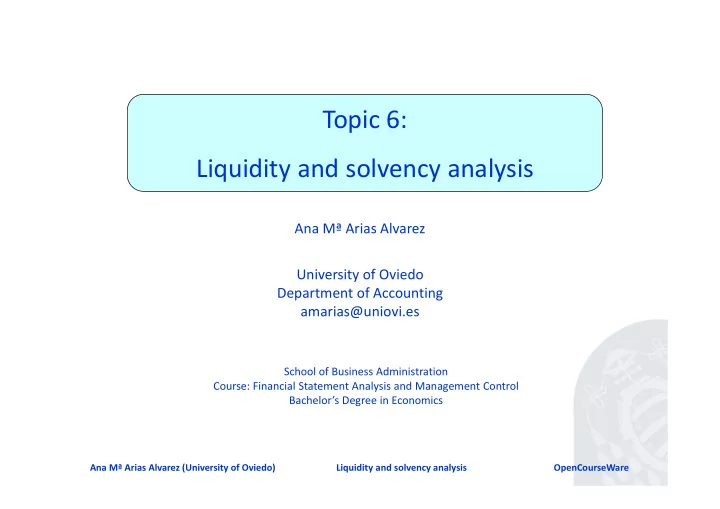

Topic 6: Liquidity and solvency analysis Ana Mª Arias Alvarez University of Oviedo Department of Accounting amarias@uniovi.es School of Business Administration Course: Financial Statement Analysis and Management Control Bachelor’s Degree in Economics Ana Mª Arias Alvarez (University of Oviedo) Liquidity and solvency analysis OpenCourseWare
6.1. Analysis of the equilibrium of financial structure. 6.2. Techniques and ratios for financial analysis. 6.2.1. Short ‐ term financial analysis. 6.2.2. Long ‐ term financial analysis . 2/12 Ana Mª Arias Alvarez (University of Oviedo) Liquidity and solvency analysis OpenCourseWare
6.1: ANALYSIS OF THE EQUILIBRIUM OF FINANCIAL STRUCTURE. WORKING CAPITAL Current assets – Current liabilities = Current assets – Current liabilities = (Equity +Non ‐ current liabilities ) – Non ‐ current assets (Equity +Non ‐ current liabilities ) – Non ‐ current assets Working capital is the portion of current assets which is financed with long ‐ term funds. 3/12 Ana Mª Arias Alvarez (University of Oviedo) Liquidity and solvency analysis OpenCourseWare
6.2: TECHNIQUES AND RATIOS FOR FINANCIAL ANALYSIS. ● Liquidity ratios Short ‐ ● Operating cash cycle (OCC) term ● Other ratios ● Ratios of structure Long ‐ ● Debt to equity ratios term ● Total assets to debt ratio 4/12 Ana Mª Arias Alvarez (University of Oviedo) Liquidity and solvency analysis OpenCourseWare
6.2.1: SHORT ‐ TERM FINANCIAL ANALYSIS. a) LIQUIDITY RATIOS: 5/12 Ana Mª Arias Alvarez (University of Oviedo) Liquidity and solvency analysis OpenCourseWare
b) OPERATING CASH CYCLE (OCC): Purchase of goods Cash received from Sale of goods on credit credit customers on credit 60 days Inventories holding Settlement period period for trade 50 days receivables 10 days Payment for goods Settlement period for trade payables 40 days 20 days The OCC is important when assessing the liquidity of a business. In the case of a commercial company, it may be defined as the time period between the outlay of cash necessary for the purchase of goods and the ultimate receipt of cash form the credit customer. 6/12 Ana Mª Arias Alvarez (University of Oviedo) Liquidity and solvency analysis OpenCourseWare
CALCULATING THE OCC Average period Numerator Denominator Inventories holding Average inventories held Cost of sales period plus Settlement period Average trade receivables Net sales for trade receivables minus Settlement period for Average trade payables Net purchases trade payables 7/12 Ana Mª Arias Alvarez (University of Oviedo) Liquidity and solvency analysis OpenCourseWare
Task: try to solve problem 6.1. 8/12 Ana Mª Arias Alvarez (University of Oviedo) Liquidity and solvency analysis OpenCourseWare
c) OTHER RATIOS: Equity + Non ‐ current liabilities = » Non ‐ current assets + Existing Working Capital » Existing Working Capital = Required Working Capital Existing Working Capital > Required Working » Capital » Existing Working Capital < Required Working Capital 9/12 Ana Mª Arias Alvarez (University of Oviedo) Liquidity and solvency analysis OpenCourseWare
6.2.2: LONG ‐ TERM FINANCIAL ANALYSIS. a) RATIOS OF STRUCTURE: ● Non ‐ current assets/Total assets ● Current assets/Total assets Asset ● Inventories/Total assets structure ● Trade receivables/Total assets ● etc. ● Equity/(Equity + Liabilities) ● Liabilities/(Equity + Liabilities) Financial ● Non ‐ current liabilities/(Equity + Liabilities) structure ● Current liabilities/(Equity + Liabilities) 10/12 Ana Mª Arias Alvarez (University of Oviedo) Liquidity and solvency analysis OpenCourseWare
b) DEBT TO EQUITY RATIOS: ● Long ‐ term Non ‐ current liabilites/Equity ● Debt to equity Liabilities/Equity ● Short ‐ term Current liabilities/Equity c) TOTAL ASSETS TO DEBT RATIO: 11/12 Ana Mª Arias Alvarez (University of Oviedo) Liquidity and solvency analysis OpenCourseWare
Task: try to solve problem 6.2. 12/12 Ana Mª Arias Alvarez (University of Oviedo) Liquidity and solvency analysis OpenCourseWare
Recommend
More recommend